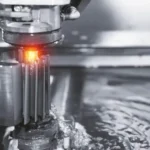Electrical Discharge Machining (EDM) has revolutionized the way manufacturers approach the creation of intricate metal components. In an industry where precision, accuracy, and quality are paramount, EDM Machining stands out as a critical solution for producing complex shapes that traditional machining methods struggle to achieve. From aerospace to medical devices and automotive applications, EDM Machining offers unparalleled benefits in terms of precision and efficiency. This article delves into why EDM Machining is essential for complex metal parts and how it has become the go-to process for advanced manufacturing needs.
Understanding EDM Machining and Its Unique Capabilities
EDM Machining is a non-traditional manufacturing process that uses electrical discharges, or sparks, to erode material from a workpiece. Unlike conventional cutting methods that rely on mechanical force, EDM Machining operates without direct contact between the tool and the material. This unique approach makes it possible to machine even the hardest metals with exceptional accuracy. By employing an electrode and a dielectric fluid, EDM Machining creates complex shapes, deep cavities, and fine details that are otherwise difficult to achieve.
What sets EDM Machining apart is its ability to work with materials that are too tough for traditional machining. High-performance alloys, hardened steels, and conductive materials are easily handled using this process. The absence of cutting forces eliminates tool wear, making EDM ideal for producing delicate features with tight tolerances. Its precision capability ensures that manufacturers can meet demanding specifications, making it an indispensable technology for industries that require reliability and accuracy.
The Role of EDM Machining in Producing Intricate Geometries
Complex metal parts often feature intricate geometries, narrow slots, and sharp internal corners that are challenging to create using traditional methods. EDM Machining excels in these scenarios because it can shape metal components with extreme precision, regardless of their complexity. This capability is vital for industries such as aerospace, where components often have irregular shapes and tight tolerances for performance and safety.
Additionally, EDM Machining allows manufacturers to create features without introducing stress or deformation into the material. Since there is no physical cutting pressure, the risk of distortion is minimized, ensuring that delicate and high-precision parts retain their dimensional accuracy. Whether it’s micro-machining for medical implants or crafting intricate molds for injection molding, EDM Machining proves its worth by enabling designs that were once considered impossible.
EDM Machining and Material Versatility
One of the key reasons EDM Machining is essential for complex metal parts lies in its material versatility. Traditional machining techniques can struggle when dealing with hardened steels, titanium alloys, or other tough materials. EDM, however, thrives in such conditions. As long as the material is electrically conductive, it can be machined with ease using this technology. This makes EDM a preferred choice for industries that utilize high-performance materials, such as aerospace and defense.
Moreover, the process works equally well for small and large components. Whether you need intricate details on tiny components or deep cavities in large molds, EDM Machining handles the task efficiently. Its adaptability allows manufacturers to streamline production processes without switching between different machining methods for various materials, making it a cost-effective and reliable solution for complex parts.
Advantages of EDM Machining for High-Precision Applications
EDM Machining offers several advantages that make it the preferred choice for high-precision applications. One significant benefit is its ability to produce burr-free components. Unlike conventional machining, which often requires secondary operations for deburring, EDM leaves a smooth and precise finish, reducing the need for additional processing. This translates into time and cost savings for manufacturers.
Another major advantage is the ability to maintain tight tolerances, often within a few microns. This level of precision is critical in industries such as medical device manufacturing, where even the smallest deviation can impact functionality. EDM Machining also provides excellent surface finishes, which is crucial for components like molds and dies that require a polished surface for optimal performance. Combined, these benefits highlight why EDM Machining is indispensable for achieving accuracy and consistency in complex metal parts.
Future of EDM Machining in Advanced Manufacturing
As manufacturing continues to evolve, EDM Machining is set to play an even greater role in producing complex metal components. With advancements in automation, CNC technology, and digital integration, EDM systems are becoming faster, smarter, and more efficient. This progress allows manufacturers to handle larger production volumes while maintaining the same level of precision and quality.
Furthermore, as industries like aerospace, automotive, and medical technology continue to demand lightweight yet durable components, EDM Machining will remain a critical tool in meeting these requirements. Its ability to machine hard materials with minimal stress, combined with its adaptability to complex geometries, ensures that EDM will stay at the forefront of precision manufacturing. Companies that invest in EDM technology today are positioning themselves to meet the challenges of tomorrow’s advanced engineering needs.
Final Thoughts
EDM Machining is no longer just an alternative method; it is a necessity for producing complex metal parts across various industries. Its ability to handle intricate designs, work with tough materials, and deliver unmatched precision makes it a cornerstone of modern manufacturing. As technology continues to advance, EDM Machining will only become more integral to creating high-quality, reliable, and innovative components for the future.

